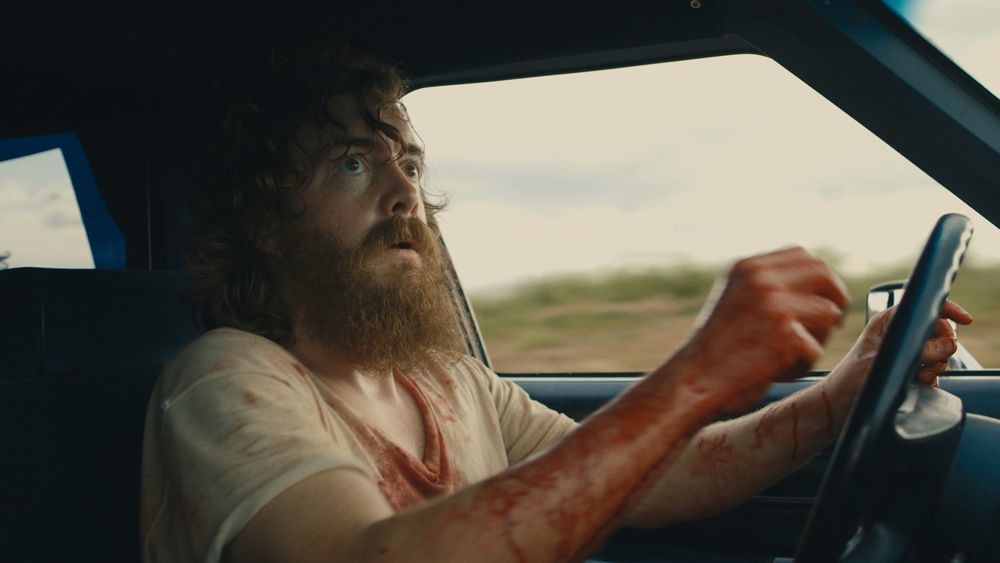The Devastating Jeremy Saulnier
2013 was unusually blue year for cinema; films like Bluebird, Blue Caprice, Blue Jasmine, Blue is the Warmest Color, and Jeremy Saulnier’s revenge thriller, Blue Ruin, all screened at festivals, with the latter two opening at the Cannes Film Festival. For an emerging filmmaker like Saulnier, however, the coincidence is an unforseen hurdle. In spite of the film’s success at Cannes (it won the FIPRESCI Director’s Fortnight Prize), Saulnier continues to fret: “The trouble with independent films is that they retitle it or rebrand it after its premiere, and you don’t have many opportunities for outreach to define your place in the market.”
For Blue Ruin, a classic revenge story of two feuding families, the title vitally shapes the film’s personality. The camera is always trained closely on Dwight Evans (Macon Blair), the homeless, impressively bearded, somber-eyed protagonist who lives in his battered old car in the heart of rural, pro-gun Virginia. The beginning unfolds in a daze of silent, strange, sun-bleached banalities: Dwight sleeping, Dwight eating, Dwight breaking into a house to bathe. This pattern is broken when Dwight is awoken by a sympathetic police officer who informs him that his parents’ killer, Will Cleland (David W. Thompson), is being released from prison. After driving over to watch Will reunite with his family, Dwight instinctively follows the party to a bar and fatally stabs Will in the bathroom. Having rekindled the old enmity, a blood-covered Dwight goes both on the run from and in pursuit of the vengeful family. The film’s violence is biblical; as Saulnier says, “This movie could take place easily hundreds of years ago with swords instead of guns.”
“Blue ruin” is an expression meaning “complete and utter ruin, desolation.” It’s a nostalgic, nihilistic, twilight state of being. This is the state in which Dwight permanently exists. He doesn’t rage with testosterone as he aims his weapons; though highly sensitive, he moves mechanically, as though by offensive reflex.
Following 2006’s comedy-horror Murder Party, which won Best Feature at the Slamdance Festival, Blue Ruin is an uncharacteristically delicate sophomore film for Saulnier. A native of Alexandria, Virginia, the director began experimenting with film as a child. With a few local friends, Saulnier managed to turn each school project “into a sort of epic video.” Together, their aesthetic was much less Coen Brothers and much more, in Saulnier’s words, “bizarro”: zombie movies, Monty Python, Reagan-era action movies, and ultraviolence, erupting unpredictably and in excess. “The first movie I’ve made was called Megacop,” he laughs. “It was kind of like RoboCop meets Miami Vice. We had drug dealers, bags of cocaine, and lots of big guns and fake blood.”
As an adult, Saulnier, a commercial director by day, was prone to bursts of creative output on the side funded by his life savings. For Blue Ruin, the process was made slightly less risky with the help of a successful Kickstarter campaign.
We spoke to Saulnier over the phone about the finer things in film, including revenge and big guns.
HANNAH GHORASHI: Tell me about your background. I know you were making movies before Blue Ruin, and you also shot commercials professionally. But what was going on before then? Did you go to film school?
SAULNIER: When I was applying to colleges, I never actually entertained the idea of going anywhere besides NYU film school, and I got in there. I met lots of friends, and we rotated group positions—I was used to that, because that’s how we made movies growing up. There was no real division of labor. We did stunts and makeup effects and acted and directed and shot—all that stuff wrapped into one. It was a great experience for me. I gravitated towards camera because a teacher gave me that nudge—he saw one short film that I had photographed for a classmate and he recommended that I stick with the camera. So I did, and I started a parallel career track. I always wanted to be a director, I always wanted to make my own movies, but it just helps to have a technical trade to lean back on. When I graduated from film school, I had to start from scratch. I was a production assistant for a couple of years and then I declared myself a cameraman and shot corporate videos and commercials and worked my way up the ranks. Every so often I’d get the bug and I’d have to do something creative, whether it be a short film or, in 2006, it was Murder Party. I never gave up until things actually lined up for Blue Ruin. It was a great cross-section.
GHORASHI: I’m curious about the people you grew up with—are they still making films now, or have they gone in different directions?
SAULNIER: Some of them. A bunch of them have given up film, but Macon Blair, the lead actor in Blue Ruin, was one of the core members of that group growing up. Our first film together was actually in 1988.
GHORASHI: I thought you might be related because you look a little similar.
SAULNIER: [laughs] No, we are not related, but I guess we are kind of bros. [laughs] The convict in the bathroom scene in Blue Ruin—that’s another one of our friends from our youth. Chris Sharp, the star of Murder Party, is also an associate producer on Blue Ruin, and he was part of that same crew.
GHORASHI: Where did the title of Blue Ruin come from?
SAULNIER: The title of the movie was just a search. We were searching the word “debacle,” and I came across the words “blue ruin.” It was just the perfect fit. I was really adamant about not wanting to be aggressive or exploitative with the title. Other ideas we had at the top of the list were just too aggressive for me, and I love the fact that going into this movie cold, before there were trailers and a PR campaign, when it was going through festivals, people knew nothing about the movie. I didn’t want to tip my hand. When this movie suddenly starts off as a genre movie on a downward spiral, it was just so surprising. People never knew how this film was going to go. Blue Ruin has more of the feminine, melancholy vibe that I wanted that relates more to the opening scenes of the film and that atmosphere.
GHORASHI: I read that this movie was actually going to be a comedy, about a homeless guy who’s hired to kill someone’s dog.
SAULNIER: That’s true.
GHORASHI: But someone else was already making the same movie. I thought that was really hilarious because, not only what are the chances of that happening, but the movie turned out very differently, obviously. Were there parts, like when Dwight is shot with a crossbow in the thigh, that were humorous scenes in the original movie?
SAULNER: The character always stood alone as some guy who needed to explore, with Macon playing that role. But those early dark comedy premises were just one-sentence pitches. I had couple of openings for the film that I had jotted down, but it never really progressed past that point, because when Macon emailed me that Seven Psychopaths had a similar premise, I just threw up my hands and said, “Of all the bizarro premises.” It wasn’t high concept, like a haunted house in space. It was just some dude gets hired to assassinate a dog. So I said, “Let’s not do anything high-concept, let’s just do a film that no one’s going to steal the idea for—a revenge movie. That’s the most standard thing we can do. It’s like comfort food. We’re going to embrace the fact that this is not a wholly original premise, but explore it from a new direction and thrust this unlikely protagonist in the mix. Hopefully that’s where we’ll find our groove.” It wasn’t until this whole revenge scenario took hold that we actually moved forward with development and writing the script. When it turned into a dark comedy, that’s just how we make movies and we love seeing the world that way. We never had the characters aware of the comedy and the rule was that Macon’s character could never play for laughs. The fact that he didn’t quite belong in the movie and was way in past his depth, it would just arrive naturally—this ineptitude that this character had that would conflict with the traditional, aggressive testosterone-fueled mission.
GHORASHI: Did he ever train as an actor?
SAULNIER: Not a lot of formal training, but he’s been training to act since he was 10 years old. He’s been in front of the camera since the late ’80s. [laughs] We had this very physical approach to acting, this very tactile approach to making movies and it’s very important to me. I take it for granted, but he is nearly indestructible and he’ll do stunts—he’ll light himself on fire and tape firecrackers to himself and they’ll explode on his chest—all kinds of stuff. But as he went through film school, he’s also a writer, and [so] Macon is keenly aware of story. He often, during Blue Ruin, would act as the keeper of the story and be faithful to it. He just knew everything from a writer’s perspective, [and] that really helped guide him on set. A lot of our preparation for this film was done before we shot, and we had exhausted discussion and negotiations about the character, whether he would drink booze or tea or what would actually compel him to embark upon this mission because it was so far beyond his scope. But Macon has taken acting classes and again, he had the privilege of just being in the trenches, making movies.
GHORASHI: On the violence in the film—were you interested in the socioeconomic aspect of that, as in that these people that are living in this rural area have much more of a gun culture?
SAULNIER: Being a Virginia film of a certain ilk, guns were just always part of it, and I think there’s a high concentration of guns in very few hands. Where I grew up in Virginia with my friends, I didn’t know any of them who had guns in their home, so guns were not part of my life but they’re definitely very native to Virginia. [laughs] But I really didn’t think too much about it. There were actually a few jabs at gun control laws in Virginia in the first two drafts of the script that I removed because I thought, “The presence of guns says enough; I don’t need to get political here.” The film speaks for itself, and it’s also conflicted—guns come in quite handy in some scenes. They are tools, and they are deadly, but that’s their purpose and there are lots of them around. We use them to act on impulse, but it was more about the narrative drive.
GHORASHI: I was really interested in Dwight too, because like you said, he’s not this aggressive cliché in his pursuit of the Clelands.
SAULNIER: I think that’s what really set the movie apart—that he is compelled by deep sorrow and vulnerability and emotion. It’s not really bloodlust; it’s his inability to move on and his preoccupation with his parents’ death. For me, his drive is closure. The thrust is about family and about sorrow and not about aggression.
GHORASHI: What do you think could stop this cycle of revenge that’s so in-house for the two families?
SAULNIER: Just someone, on one side or the other, to make a choice, a sacrifice, and not have the last word. I’ve explored many resolutions to this film, and ultimately it is a movie for an audience. I wanted it to be, if not an uplifting film, a dramatically satisfying movie. So that superseded all my decisions as an artist—I needed this to play for an audience.
BLUE RUIN OPENS IN LIMITED RELEASE TOMORROW, APRIL 24.







